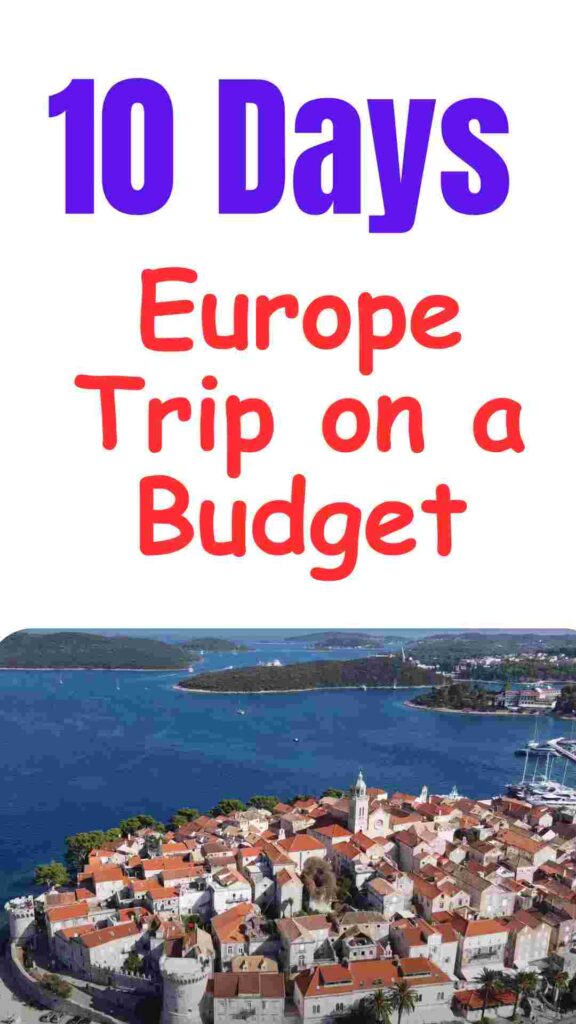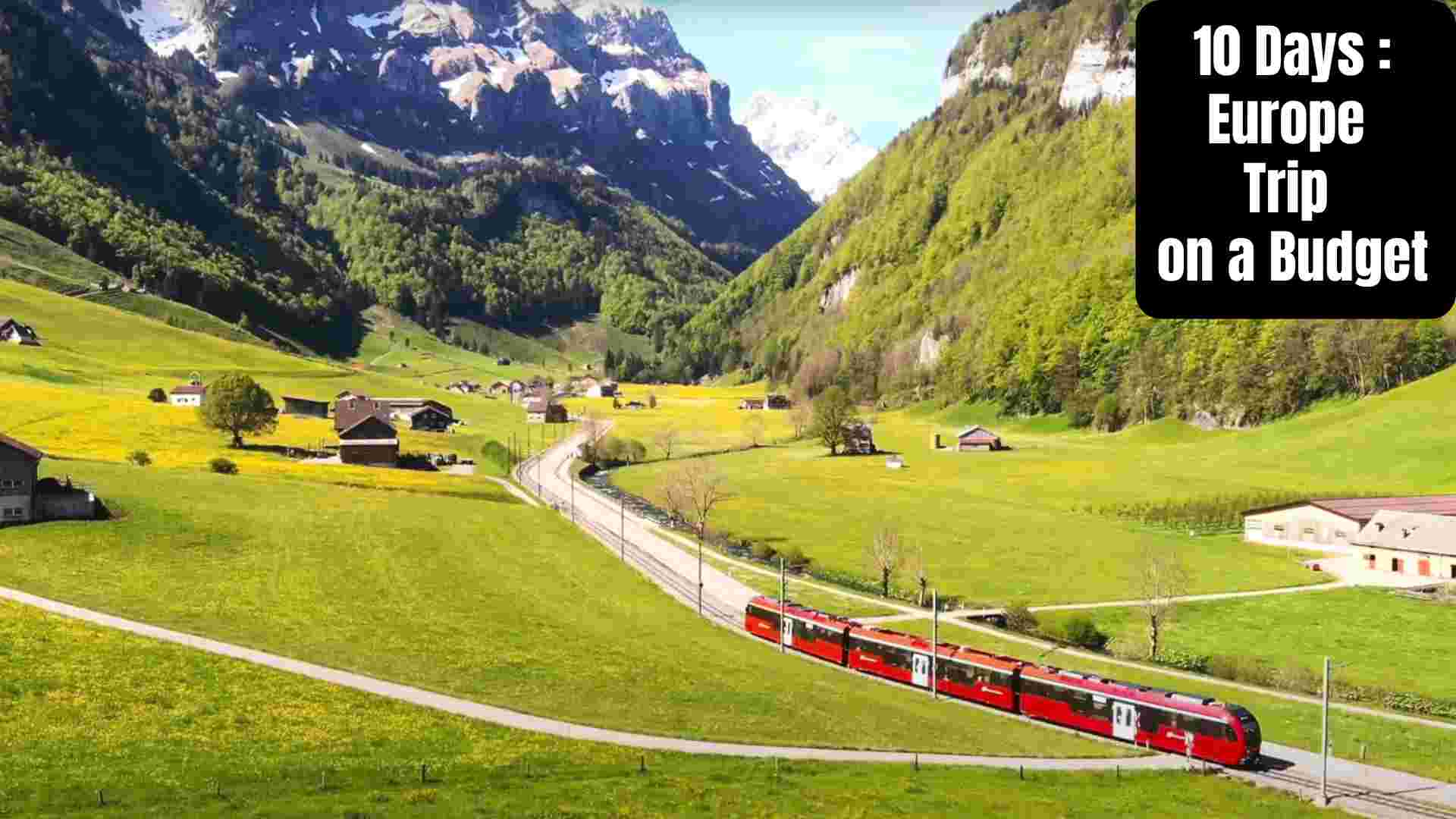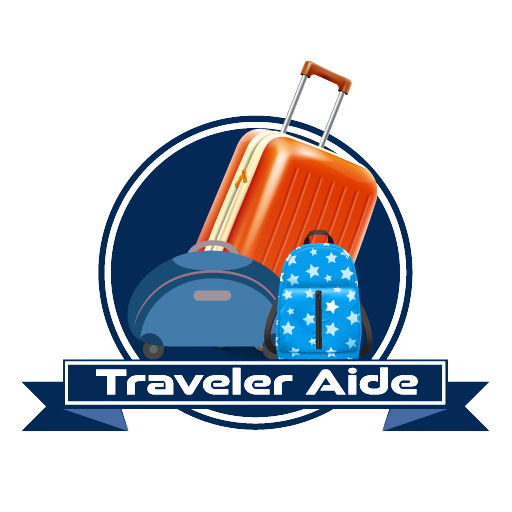Planning a trip to Europe can feel overwhelming—especially if you’re worried about money. But here’s the good news: you absolutely can explore Europe in 10 days without draining your savings. I did it, and I’ll walk you through exactly how.
This guide is perfect for you if:
- You’ve got around 10 days off
- You want to visit multiple countries
- You’re working with a tight budget
- You want real advice, not just dreamy Instagram shots
Whether you’re a student, a solo traveler, or just trying to stretch your euros, I’ve packed this itinerary with smart tips, affordable routes, and budget-friendly stays.
The Budget Game Plan
Here’s the basic idea: stick to Central and Eastern Europe, travel by train or budget airline, stay in hostels or Airbnbs, and eat like a local. Europe may have a reputation for being pricey, but some parts are surprisingly affordable.
Here’s what worked best for me:
- Start in a cheap entry hub (like Budapest or Prague)
- Focus on cities with strong value-for-money
- Use night trains or buses to save on accommodation
- Book flights and trains early
- Carry a light backpack (less luggage = fewer fees)
And most importantly, be flexible. Spontaneity can save you money—and lead to amazing memories.
Budget Snapshot (What I Spent)
Here’s a rough idea of my budget for 10 days in Europe (excluding flights from my home country):
| Item | Daily Avg | Total (10 Days) |
| Accommodation | €25 | €250 |
| Food | €15 | €150 |
| Transportation | €10 | €100 |
| Activities/Attractions | €10 | €100 |
| Misc. (souvenirs, coffee, etc.) | €5 | €50 |
| Total | €650 |
€650 for 10 days across 3–4 countries? Totally possible. You just have to be smart about where and how you spend.
Day-by-Day Itinerary: 10 Days in Europe on a Budget
This route focuses on Central and Eastern Europe, where your euros go a lot further. You’ll get charming old towns, scenic train rides, and a mix of cultures—without the high price tag of Western Europe.

Day 1–3: Budapest, Hungary
Why start here? Budapest is stunning, affordable, and well-connected. Plus, the thermal baths are perfect for kicking off your trip.
Where to stay:
- Maverick City Lodge (budget hostel with great vibes)
- Airbnb in Jewish Quarter (central and cheap)
Must-do on a budget:
- Stroll along the Danube and cross the Chain Bridge
- Soak in Széchenyi Baths (bring your own towel!)
- Visit Fisherman’s Bastion (free and gorgeous views)
- Try local eats at Karavan Street Food Court
- Ruin bars at night (especially Szimpla Kert—entry is free)
Daily Spend: ~€50 (including hostel, meals, transport, and entry)
Travel Tip: Take the overnight train or Flixbus to Vienna. Booking early gets you a ticket for as low as €15.
Day 4–5: Vienna, Austria
Vienna is elegant and cultured, and you can still enjoy it on a budget with a bit of planning.
Where to stay:
- Wombat’s City Hostel (central, clean, and lively)
- If solo, try couchsurfing—Austrians are welcoming!
Budget-friendly activities:
- Walk around the Innere Stadt (historic center)
- Visit St. Stephen’s Cathedral (free)
- Explore Belvedere Gardens (free)
- Catch a standing ticket at the opera for €3–5
- Have a picnic at Stadtpark with groceries from Billa
Daily Spend: ~€60 (Vienna is pricier than Budapest)
Getting to Prague: Flixbus or RegioJet train (~€20, 4 hours)
Day 6–7: Prague, Czech Republic
You’ll feel like you’ve walked into a fairy tale—and your wallet will thank you.
Where to stay:
- Czech Inn Hostel (great design + cheap breakfast)
- Budget hotels start around €30–40 per night
Don’t miss:
- Charles Bridge (sunrise walk is magical)
- Free walking tour of the Old Town
- Prague Castle and Golden Lane
- Eat like a king for €5 at Lokal or Havelska Koruna
- Try trdelník (pastry) and Czech beer (cheap and tasty)
Daily Spend: ~€45
Next stop: Overnight bus to Kraków or cheap flight (€10–20 with Ryanair if booked early)
Day 8–9: Kraków, Poland
Kraków is one of the most underrated cities in Europe. It’s rich in history, easy on the wallet, and full of charm.
Where to stay:
- Greg & Tom Hostel (free breakfast and dinner!)
- Private rooms available under €30 if you book ahead
Top budget activities:
- Explore the Old Town and Main Market Square
- Visit Wawel Castle grounds (free to walk around)
- Take a somber but important visit to Auschwitz (~€15–€25 with transport)
- Join a free walking tour—they’re everywhere
- Try pierogi at Milkbar Tomasza (hearty meals under €5)
Daily Spend: ~€40
Travel Tip: Kraków’s old town is compact—walk everywhere and save on public transport.
Next stop: Head back to your starting point or make your way to your final city.
Day 10: Back to Budapest or Fly Out
Depending on your flight, you can:
- Loop back to Budapest by night train (~€20–30)
- Or fly out from Kraków or nearby cities (many budget airlines operate here)
Use apps like Omio, Rome2Rio, or Skyscanner to find the cheapest transport option. If you fly out, choose early morning flights—they’re usually cheaper.
Flexible Alternative: Swap Cities Based on Flight Deals
Not into trains or don’t want to circle back? No problem. You can easily flip or rearrange this route depending on where you find cheap flights. Other great budget hubs to consider as start or end points:
- Berlin (super cheap hostels + nightlife)
- Bratislava (quick day trip from Vienna)
- Ljubljana (a bit more hidden, but stunning)
Europe is surprisingly flexible. You don’t have to follow a rigid plan—just watch those transport deals!
Smart Budget Travel Tips That Actually Work
1. Book Early, Especially for Trains and Buses
If you know your route, book your Flixbus, RegioJet, or train tickets in advance. Last-minute prices can double. Apps like Omio or Trainline help compare and book with ease.
2. Skip Taxis — Use Public Transport or Walk
Most cities on this route are walkable, especially the old towns. Public transport is cheap and reliable. Get a 24-hour transport pass if you plan to move around a lot (especially useful in Vienna and Budapest).
3. Eat Local, Not Touristy
Restaurants near major landmarks are tourist traps. Go just a few blocks out and you’ll find:
- Street food for €3–5
- Daily specials at local bistros
- Bakeries with filling sandwiches and pastries
Look up places with good reviews on Google Maps or HappyCow (especially if you’re vegetarian/vegan).
4. Free Activities Are Everywhere
Take advantage of:
- Free walking tours (tip your guide at the end)
- Parks, riverside walks, open-air markets
- Churches and cathedrals (most don’t charge entry)
- Museum discount days (check local schedules!)
5. Travel Light (Seriously)
The lighter your bag, the happier you’ll be. You’ll avoid airline baggage fees, move around faster, and not feel weighed down.
Pack:
- 2 pairs of shoes (1 walking, 1 light sneaker/sandal)
- 3–4 mix-and-match outfits
- Reusable water bottle
- Compact daypack
- Travel-size toiletries
- A laundry bar or a couple of detergent pods (wash your clothes halfway through)
Bonus: Most hostels have laundry for €2–€4.
Budget Travel Tools I Swear By
These apps and websites helped me stay under budget and stress-free:
- Skyscanner / Google Flights – for tracking cheap airfare
- Rome2Rio / Omio – to compare trains, buses, and flights
- Flixbus / RegioJet – budget buses and trains
- Booking.com / Hostelworld – to find cheap and well-reviewed stays
- Maps.me – offline maps with walking routes
- XE Currency – for quick conversion
- Splitwise – if you’re traveling with friends
- Trail Wallet – budget tracker on the go
A bit of planning goes a long way in stretching your euros.
What to Pack for 10 Days in Europe (Budget Style)
Packing light isn’t just about convenience—it saves money. Here’s what I fit in my 35L backpack:
Essentials:
- 1 pair of comfortable walking shoes
- 1 lightweight sandal or sneaker
- 3–4 T-shirts or tops
- 2 pairs of pants or shorts
- 1 light jacket or hoodie
- 1 dress or nicer outfit (for evening or cultural sites)
- 5 pairs of underwear and socks
- Reusable water bottle
- Universal adapter
- Quick-dry towel
- Toiletries in travel-size bottles
- Mini first aid kit (band-aids, painkillers)
- Small lock (for hostel lockers)
Optional but helpful:
- Eye mask and earplugs (for buses/hostels)
- Laundry soap or bar
- Power bank
- Printed or digital copies of bookings
Travel tip: Roll your clothes to save space and reduce wrinkles. And remember—you can do laundry halfway through the trip.
Common Budget Travel Mistakes (and How to Avoid Them)
- Not checking baggage fees on budget airlines
→ Always read the fine print. Some “cheap” flights charge more for a carry-on than the flight itself. - Overpacking and regretting it
→ Less is more. You really don’t need 10 outfits for 10 days. - Skipping public transport out of fear
→ Buses, trams, and metros are safe, clean, and way cheaper than taxis. - Assuming everything needs a ticket
→ Some of the best views, churches, and historic sights are totally free. - Changing money at the airport
→ Avoid it. Use ATMs in the city center for better rates, or get a card with no foreign transaction fees (like Revolut or Wise).
Final Thoughts
The idea of traveling Europe on a tight budget can feel impossible—but it’s 100% doable. With a little planning and flexibility, you’ll realize that some of the best memories don’t cost a thing: watching a sunset in Prague, getting lost in Kraków’s old town, or sharing stories with hostel mates over €1 beers.
So don’t wait until your budget is perfect. Start where you are, pack light, and go make those memories.
Your 10-day Europe trip on a budget starts now.


